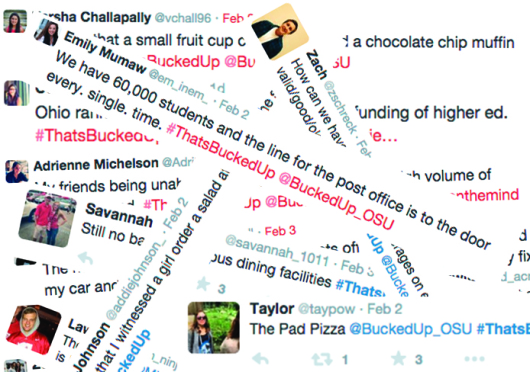Students looking to share feedback about life at Ohio State now have a new opportunity to vent on social media.
OSU’s Undergraduate Student Government launched the #ThatsBuckedUp campaign on Sunday via Twitter and Facebook in an effort to hear student feedback more efficiently.
“This week we launched a Twitter, Facebook page, and a Google form where people can submit things they want to see fixed or improved at OSU,” said Abby Waidelich, a USG spokeswoman and a third-year in biological engineering.
USG will evaluate responses and provide feedback to students, including advice on whether their problems can be solved administratively, Waidelich said.
USG President Celia Wright, a fourth-year in public health, said it’s important to have town hall meetings and general assemblies, but more needs to be done. Social media is a tool that needs to be used, she said.
“A big part of our responsibility in student government is to represent students’ needs,” Wright said.
The morning after the launch of #ThatsBuckedUp on Twitter, which has the handle @BuckedUp_OSU, the amount of followers and posts increased as more people found out about it, Waidelich said.
“This took off like none other after the launch,” Waidelich said. “We made it public Sunday night during the Super Bowl and it really took off Monday morning and the amount of followers tripled in about two hours. It’s been very successful so far.”
As of Wednesday evening, the @BuckedUp_OSU account had more than 290 followers and had tweeted 29 times.
Although many of the tweets including the #ThatsBuckedUp hashtag voice serious concerns, ranging from off-campus safety to pricing at on-campus dining facilities, some students have used the hashtag in a more light-hearted manner.
“It’s been entertaining to see how students have been using it,” Wright said. “Some students have used it to make people aware of serious issues and some people have used it to be funny, both of which we enjoy.”
Waidelich agreed that whether the hashtag was being used strictly to voice legitimate OSU concerns or to post good-natured tweets, the end result is the same.
“With people posting funny things to the hashtag, at least that is getting the word out that USG wants to hear back from students,” she said. “The more often they see our hashtag or Twitter handle, the more likely they are to click either on our Facebook page or Twitter to see what we actually are doing.”
Zach Schreckenberger, a first-year in biology, recently posted to the hashtag about class averages on exams, but said he isn’t totally sure it’s going to make any difference.
“I don’t know how confident I am that the issues posted will be addressed, but I think just mentioning it does something at least,” he said. “We’ll see, I don’t really know what USG’s plan is. If USG or the administration actually sees these posts and actively works on it, I would continue to use this.”
Addie Johnson, a second-year in health and rehabilitation sciences, said she thinks the hashtag on Twitter is more widely read than the other platforms used by the campaign, which include Facebook and a Google form.
“I would most likely use Twitter,” said Johnson. “I feel like word spreads more quickly through the trending hashtags and retweets. I’m more likely to pay attention to what my friends are retweeting or favoriting.”
Wright said she thinks this campaign shows that USG is listening, even when it is not election season.
“In general, we have had an issue with student government only showing up in spring for campaigns,” Wright said. “It’s a problem that has been long recognized. We know that student government members are capable of getting the word out, but unfortunately that passion sometimes dies when the campaign ends. This is us ensuring that it doesn’t die and that we are able to represent students even when it isn’t when someone is trying to get elected.”



